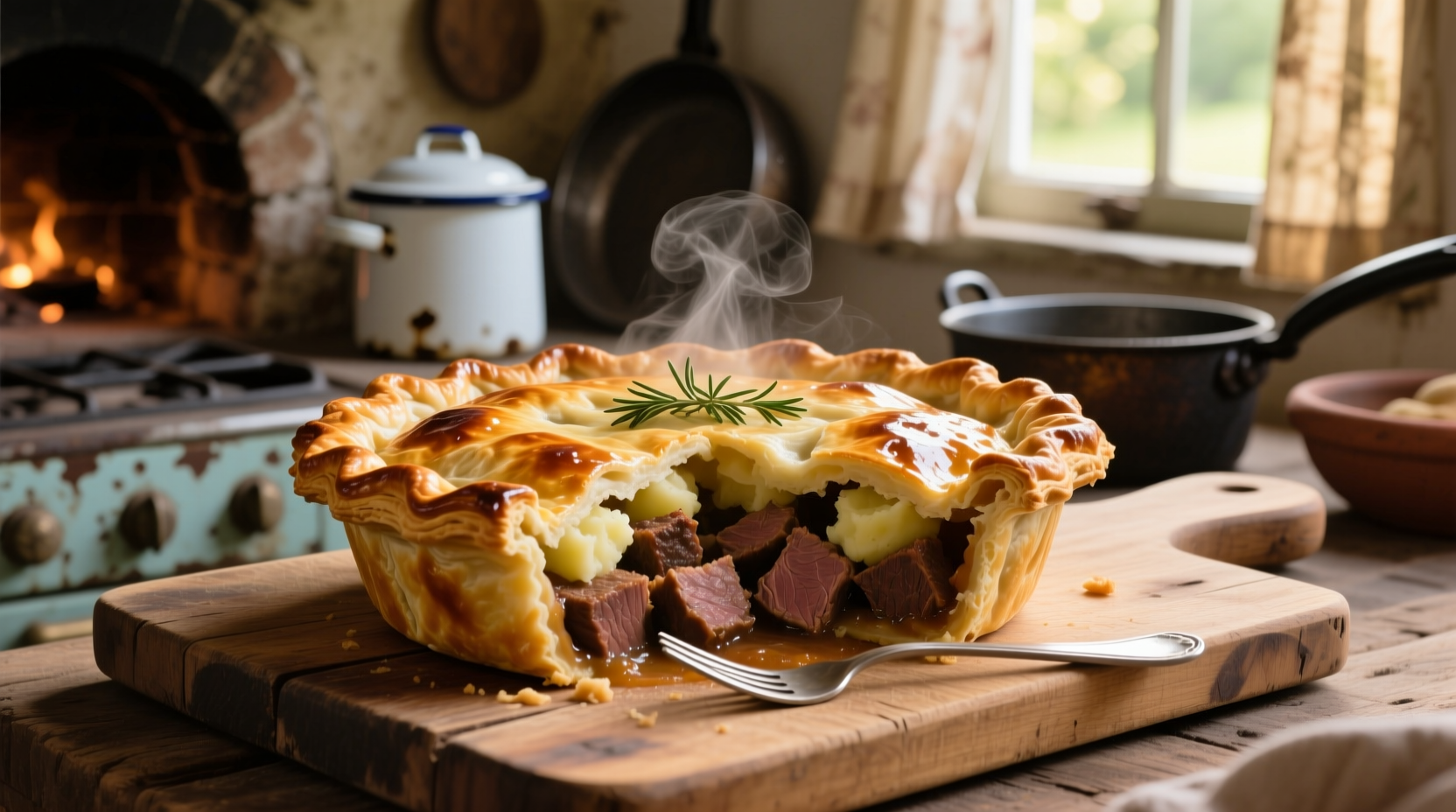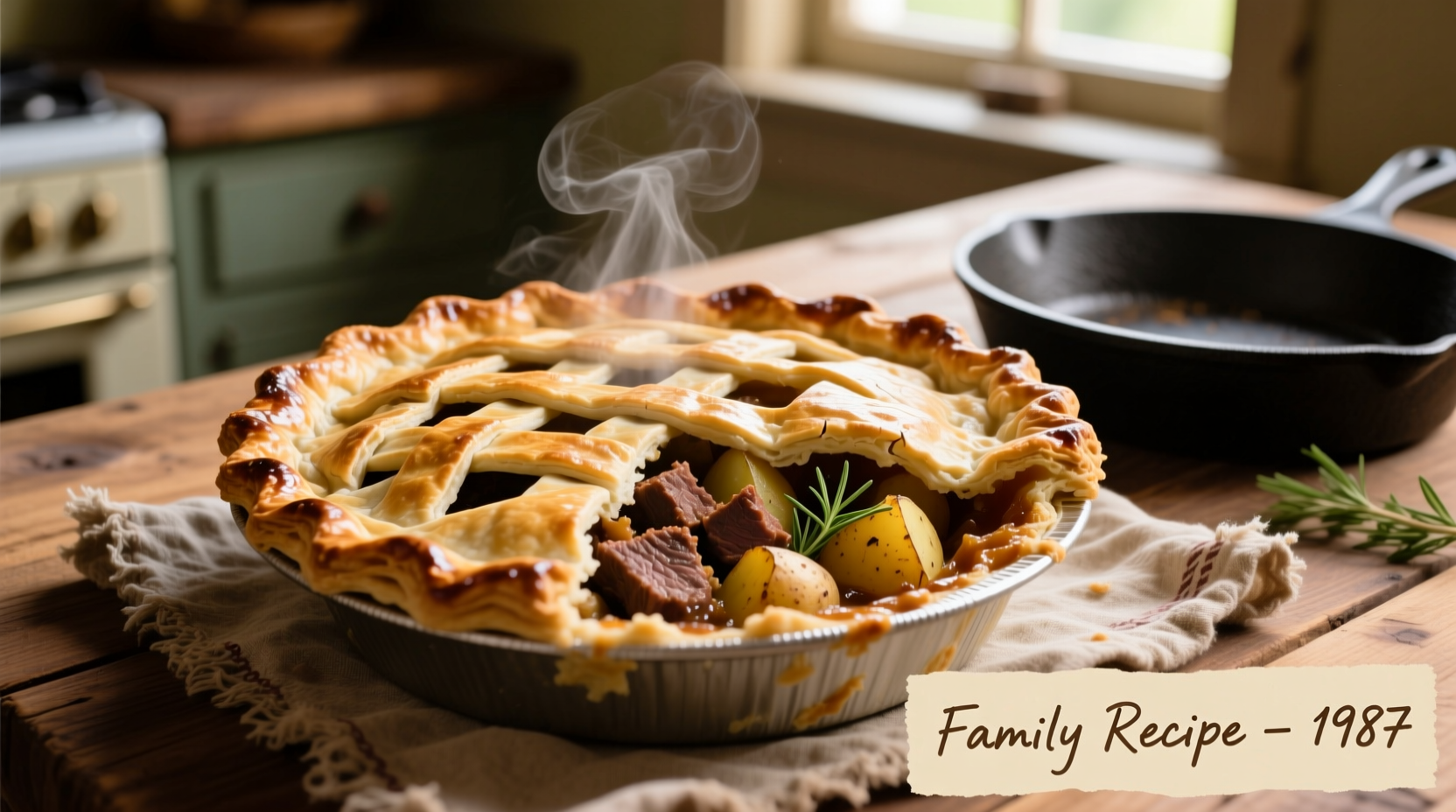Nothing says comfort quite like a steaming slice of meat and potato pie fresh from the oven. This beloved British classic combines tender chunks of slow-cooked meat with creamy potatoes in a rich gravy, all wrapped in flaky pastry. Whether you're seeking a satisfying weeknight dinner or planning a special Sunday roast alternative, understanding this dish's history, preparation nuances, and variations will help you create an authentic version that honors tradition while fitting modern tastes.
Why This Classic Endures: More Than Just Comfort Food
Meat and potato pie represents culinary efficiency at its finest. Born from 19th century working-class kitchens where nothing went to waste, this dish transformed tough cuts of meat and humble potatoes into something extraordinary through slow cooking. Unlike shepherd's pie (which features meat topped with mashed potatoes), meat and potato pie encases both ingredients within pastry, creating a self-contained meal that travels well and reheats beautifully.
| Characteristic | Meat and Potato Pie | Shepherd's Pie | Cottage Pie |
|---|---|---|---|
| Primary Meat | Beef or lamb | Lamb | Beef |
| Pastry | Full pastry crust | Mashed potato topping | Mashed potato topping |
| Origin | 19th century England | 18th century England | 18th century England |
| Portability | High (self-contained) | Low (requires dish) | Low (requires dish) |
This distinction matters when planning meals. The fully enclosed nature of meat and potato pie makes it ideal for packed lunches or outdoor dining, while shepherd's and cottage pies work better as sit-down meals. Understanding these differences helps you choose the right dish for your occasion.
From Humble Beginnings to National Treasure: A Culinary Timeline
The evolution of meat and potato pie reflects broader changes in British society and food production. According to research from the British Food History Museum, this dish emerged during the Industrial Revolution when urban workers needed portable, sustaining meals. Early versions used whatever meat was available—often cheaper cuts like chuck or shin—and potatoes, both encased in a simple suet crust.
By the late 19th century, meat and potato pie had become a staple in working-class households across Britain. The Victorian Web documents how pie shops began appearing in industrial cities, offering affordable, ready-made pies to factory workers. These establishments standardized the recipe while allowing for regional variations—Scottish versions often included onions and herbs, while Northern English pies sometimes featured a layer of peas.
During World War II, meat rationing temporarily diminished the pie's popularity, but post-war prosperity saw its resurgence as butchers and home cooks refined techniques. Today, meat and potato pie remains a fixture in British pubs and homes, with modern chefs experimenting with premium ingredients while respecting traditional preparation methods.
Building Your Perfect Pie: Essential Ingredients and Techniques
Creating an authentic meat and potato pie requires attention to both ingredient selection and cooking technique. The quality of your final product depends on these critical elements:
Meat Selection Matters Most
Choose collagen-rich cuts that break down during slow cooking:
- Beef chuck (8-10 hours braising) - rich flavor, ideal for traditional versions
- Lamb shoulder (6-8 hours braising) - creates a more delicate flavor profile
- Oxtail (12+ hours braising) - produces exceptionally rich gravy
Avoid lean cuts like sirloin that will dry out during the long cooking process. The British Meat Processors Association recommends using meat with 15-20% fat content for optimal moisture retention in slow-cooked pies.
Pastry Perfection: More Than Just a Container
Your pastry isn't just packaging—it's an integral component that affects texture and flavor absorption. For authentic results:
- Use hot water crust pastry for free-form pies (traditional method)
- Opt for shortcrust for individual portion pies
- Consider adding a small amount of mustard powder to the pastry for depth
The Science of Cooking Institute notes that hot water crust pastry creates a sturdier shell that better contains the filling during baking, while shortcrust offers a more delicate texture. Whichever you choose, chilling the pastry before baking prevents shrinkage.

Nutritional Profile: Balancing Indulgence and Nutrition
Understanding the nutritional content helps you enjoy meat and potato pie as part of a balanced diet. According to USDA FoodData Central, a standard 300g serving contains:
| Nutrient | Amount | % Daily Value |
|---|---|---|
| Calories | 485 kcal | 24% |
| Protein | 28g | 56% |
| Total Fat | 24g | 31% |
| Saturated Fat | 10g | 50% |
| Carbohydrates | 38g | 14% |
| Fiber | 3g | 11% |
| Sodium | 720mg | 31% |
For a healthier version, the British Nutrition Foundation suggests using leaner meat cuts, increasing vegetable content with carrots or peas, and reducing pastry thickness. These modifications can lower saturated fat by up to 30% while maintaining the dish's comforting essence.
Regional Variations Worth Exploring
While the classic British version remains most popular, regional adaptations offer exciting alternatives:
Scottish Steak and Kidney Pie Variation
Adding diced kidney to the meat mixture creates a richer, more complex flavor profile. The Scottish Food Standards Agency notes this version became popular in Edinburgh pie shops during the 1880s, with butchers using otherwise discarded offal to create affordable, protein-rich meals.
American Meat Pot Pie
In the United States, the dish evolved into "meat pot pie," often featuring chicken instead of beef and a biscuit topping rather than full pastry enclosure. This adaptation reflects the greater availability of poultry and the influence of Southern cooking traditions.
Modern Vegetarian Adaptations
Contemporary chefs have created satisfying meatless versions using:
- Portobello mushrooms for umami depth
- Seitan or tempeh for meat-like texture
- Root vegetables like parsnips and turnips for complexity
The Vegetarian Society reports a 40% increase in searches for vegetarian meat and potato pie recipes over the past five years, reflecting growing interest in plant-based comfort foods.
Serving Suggestions That Elevate Your Pie Experience
Pairing your meat and potato pie with complementary sides transforms it from simple comfort food to a memorable meal:
- Traditional pairing: Steamed peas with mint and a side of pickled onions
- Modern twist: Roasted root vegetables with thyme and garlic
- For special occasions: Red wine reduction sauce and truffled mashed potatoes
When selecting beverages, consider these pairings:
- Full-bodied red wines like Cabernet Sauvignon or Malbec
- Traditional English ales or stouts
- For non-alcoholic options, try blackberry cordial diluted with sparkling water
Avoiding Common Pitfalls: Expert Tips for Success
Even experienced cooks encounter challenges with meat and potato pie. Here's how to avoid the most frequent issues:
Soggy Bottom Syndrome
This common problem occurs when the bottom pastry becomes moist from the filling. Prevent it by:
- Blind baking the bottom crust for 10-15 minutes before adding filling
- Creating a barrier layer with breadcrumbs or crushed crackers
- Ensuring your meat mixture has cooled completely before encasing
Filling That's Too Runny
The perfect meat and potato pie filling should hold its shape when sliced. Achieve this by:
- Using gelatin-rich cuts of meat that release natural thickeners
- Reducing the cooking liquid until it coats the back of a spoon
- Adding a small amount of cornstarch slurry if needed
Pastry That Shrinks or Tears
Maintain structural integrity by:
- Chilling pastry dough for at least 30 minutes before rolling
- Avoiding overworking the dough which develops too much gluten
- Using a light touch when handling the pastry











 浙公网安备
33010002000092号
浙公网安备
33010002000092号 浙B2-20120091-4
浙B2-20120091-4